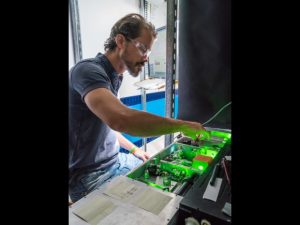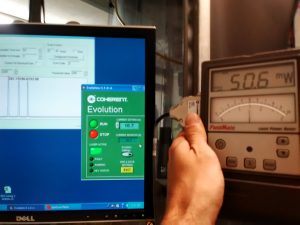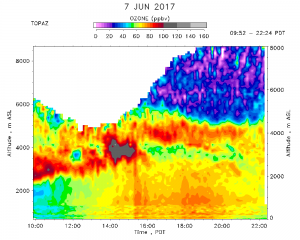The TOPAZ lidar was originally developed to be airborne, but has been truck-based since 2012. It is based on a compact solid-state laser system originally developed by NASA and incorporates state-of-the-art technologies that makes it compact and lightweight with low power consumption. On the picture below, you can see a black box that contains the laser source producing 524nm light (green) and two metal boxes with the tunable three-wavelength UV laser source.

Guillaume Kirgis with TOPAZ, Photographer: W. vonDauster
Most of the lidar operations have been automated but the laser still needs a human to make sure it’s maintaining a significant power level and 3 precise wavelengths. Normal operation (for most lidars about 2 hours) already ask maintenance on a regular basis (changing burned optics or translating crystals) but running like we do from 12 hours a day up to 61 hours continuously require another level of babysitting. Sometimes under the stress of an Intensive OPeration (IOP) it can be challenging and in some cases there would be a lot more (pardon my) French words to describe “challenging”. It takes patience, dedication and a huge amount of TLC, especially during IOPs when keeping measurements running is the top priority. Among other things we have to deal with: confine space, tiny screws and big hands; burned optics; crystals temperature, etc.
By definition, if you don’t speak laser, “to tweak” (and not twerk) means: to improve a mechanism or system by making fine adjustments to it. There is different levels of tweaking:
- The tweakers’ Grail which should be performed done in less than a minute to avoid blank in the curtain plots. It has only be mastered by a few and is originally owned by the first and only tweaking magician and guru Raul J. Alvarez.)

First 24 hours of the 61 hours run during the third IOP. Tweaks appear as white vertical bands across the plot.
- Minor tweaks are involved when minor peaks have been developing on one or more of the three wavelengths, power has become too low and the signal doesn’t reach high enough. It can take you up to 20 minutes, translating the crystal, adjusting the laser pumps and the output coupler. It will make a mark or more (white bands) on the daily curtain plot (see picture above).
- Standard maintenance (which is done after a day of experiment when the laser is still warm) usually extend your work day by an hour or two and involve chasing a bright spot in the laser beam, changing/rotating mirrors, adjusting pumps. Good maintenance will let you live “tweak-free” for maybe a few days. On the monitor you can see narrow lines with high power at minimal current.

Maintenance job.
- Last but not the least: the full “reset” when you tried already everything you know. It means you’re up for at least a good realignment of the beam path, or even full cool down of the whole system that take at least a process of 2 hours. You may also have to venture into the green laser… In that case, time does not exist anymore. Some had enter into that time space at night just to go out of the truck when the sun rise again, others a legitimate 5 to 6 hours…
So far, we always made it out alive and TOPAZ was ready to run for another day of adventure reading the atmosphere.

A perfect day on the field.
